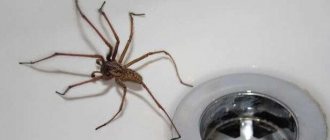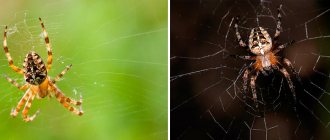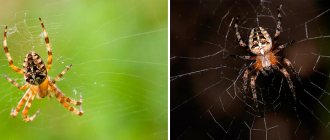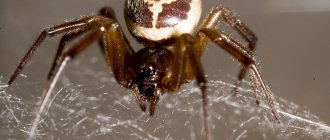Arachnophobia - fear of spiders and arachnids is one of the ten most “popular” phobias. The term itself comes from words from the Greek language: ἀράχνη - spider, ἀράχνη - horror. Arachnophobia is a special case of zoophobia, a broad category of anxiety disorders that target animal species. According to research by American psychologists, up to 50% of the female population of the United States experience panic fear of snakes, while the male population is only 10% susceptible to this phobia. At the same time, fear of spiders does not differ by gender, and the percentage of those susceptible to fear of arachnids significantly exceeds the fear of dogs and snakes.
Arachnophobia is a pathological, uncontrollable, progressive fear of spiders and any arachnids - scorpions, harvestmen and others.
Patients susceptible to arachnophobia experience a feeling of fear or severe panic not only upon contact with the object of the phobia (visual, tactile), but also upon mention of it: they may be frightened by stories about arachnids, watching television programs about these animals, as well as the sight of dead arachnids, their webs , photographs with their image. It is enough to simply hint to such a person that a spider has appeared in the room for him to have an attack of hysterics. Patients begin to scream in panic, climb onto chairs and other heights, and strive to leave the room - their fear is so strong.
Training
The training includes exercises aimed at combating arachnophobia. They can be performed under the supervision of specialists or at home. Let's take a closer look at how to get rid of arachnophobia yourself.
Exercise to distance yourself from fear
To suppress fear, you need to master relaxation techniques. The exercises involve complete detachment from the object of the phobia and denial of its significance for the individual. To do this, it is necessary to take into account the characteristics of the human psyche.
The following set of techniques will also help effectively combat arachnophobia
- We use the dissociation method to change the scale of events.
Using dissociation, it is necessary to reduce the scale of the object of the phobia. Reducing its significance and abstraction will help significantly reduce anxiety. So let's use our imagination. When faced with a spider, imagine that you are looking at it from a distance of 10 meters. Then think about what the object of your fear would look like if you looked at it through a glass window while you were outside. Now ask yourself what it would mean to you if it ended up on another planet. You will then only be able to see it through a telescope, and even then it is unlikely. Then what is the difference if the object is the same? The only difference is your perception! So your imagination helped you reduce the scary and frightening spider to a small insect unworthy of attention.
- Dissociation over time.
When faced with an object of phobia, while experiencing anxiety, think about what it will mean for you tomorrow. And in a week, a month, a year? Most likely, you will simply forget about it the next day. No matter how much you try to recall the feeling of anxiety and the accompanying physical symptoms, you will not be able to experience it again on purpose. Therefore, when experiencing fear, mentally transport yourself to the future. Remember that it is passing, and tomorrow it will not have any meaning for you.
- Changing "submodality".
This method is based on visualization of the situation. So, in your room the object of your fear is a spider. Imagine the whole situation in the form of a black and white picture. Now start modeling the image. Let the spider first increase in size and fill the entire room. Color it in bright colors to suit your taste. Now imagine how it begins to melt before your eyes - it decreases in size, its bright color fades. Reduce it to the size of a grain of sand, which will simply get lost somewhere on the floor.
Exercise "Killing a Spider"
This is an easy and simple exercise that, when performed regularly, gives good results in the fight against arachnophobia. You can do it yourself. But if the anxiety is too intense, then it is better to seek the help of a psychotherapist.
Make your own figurine of a spider from ordinary plasticine of the size and color that scares you the most. Place it in front of you and concentrate all your attention on it. Remember all the emotions that spiders cause in you, the feeling of fear, panic, your physical state. When you have managed to concentrate on your negative feelings, transfer them to the plasticine “monster”
Your emotions and the object that causes them should merge together in your imagination. Look at the situation objectively, tell yourself mentally that your fear is caused by just a small arachnid. And quite defenseless. And then have fun “killing” your spider by crushing it with your palm or stomping on it with your foot. Imagine how, together with the “killed” spider, you crushed both your fears and all the unpleasant sensations that it provoked.
An interesting fact should be noted: some peoples do not even know what fear or hostility towards spiders is. And all because arachnids serve as their daily and ordinary food. There is a lot to learn!
How is arachnophobia treated?
“I'm afraid of spiders. What should I do, doctor? — what complaints did arachnophobes seek medical help with? As with other diseases, therapy for spider phobia is sequential and consists of 3 stages: diagnosis, treatment, rehabilitation.
Diagnostics
After the conversation, the psychotherapist establishes the cause of the fear and makes it clear that he is not the only one suffering from such psychopathology. The doctor, in search of a compromise method of treatment, tries to hammer into the patient’s head that his fear of arthropods is unfounded and irrational.
Information as a way to cope with anxiety
Studying makes it possible to build a logical and reasonable system for getting rid of a phobia. For example, you can learn that there are species of spiders that spin threads of amazing golden color, from which they even make amazing and very expensive fabric. Some of the largest species take small frogs as pets and protect them in every possible way, thus protecting the laid eggs from predatory insects. How to stop being afraid of spiders? Study them and you will find that they have much more reason to fear people.
Not all species try to settle near people, it’s just that humanity creates a fairly comfortable living space. Midges and mosquitoes fly into the light of our electric lamps, and spiders intelligently try to master this buffet. Our food, rich in sugars and smelling delicious, attracts flies, someone has to hunt them!
What are the dangers of arachnophobia?
What is the fear of spiders (phobia) in terms of risk to health and life? Experts state that the disease is unsafe for humans. The main problem is panic without control. In this state, the individual tries to leave a dangerous situation as quickly as possible, without dismantling anything in his path. This is fraught with harm to the life or health of a person and others.
Important! Dangerous consequences include a constant state of stress. Arachnophobia becomes a part of a person’s life, along with an anxious expectation of a threat. On a subconscious level, the client is afraid of an unpleasant meeting all the time.
A phobia of spiders often leads to manic symptoms. For example, searching for accumulations of arthropods in order to destroy them, or a fanatical attitude towards cleanliness. It is most difficult for those people who live in regions with a southern climate, as well as those vacationing on hot continents. Neighborhood with insects is almost impossible to completely avoid. They often settle in dwellings and weave their webs in corners. Experts advise not to nurse your fears, but rather to start getting rid of them.
Exploitation of arachnophobia in art
The fear of spiders has no age limit; both children and adults are equally susceptible to it. Therefore, the image of “insidious” creatures with eight legs is actively used as a frightening factor in literature and cinema for all ages.
Photo by MART PRODUCTION: Pexels
For example, J. K. Rowling's fear eater, used to teach magic schoolchildren to confront their fears, takes the form of a huge spider in one scene. To overcome the frightening image, the student came up with the idea of “putting” roller skates on it.
The creator of “The Wizard of the Emerald City” Alexander Volkov in the book “Yellow Fog” calls the main negative character Arachne (from ancient Greek this means “spider”, which is where the name of the phobia comes from).
In addition, it is known that this is the character of the same name from ancient Greek mythology. The woman was fond of weaving, but after defying Athena and showing disrespect for the gods, she was turned into a spider. According to the myth, in the image of this creature she continues to weave her web.
Even in good literature for preschoolers, spiders are traditionally not given the most positive role. Just remember the Tsokotukha Fly, which almost became a victim of this creature.
Statistics and paradoxes
Arachnophobia is one of the most unusual and common types of fear. Statistically, it surpasses the fear of air travel and firearms, and is also relatively close on the “horror” scale to the fear of cars and car accidents.
At the same time, it is not entirely ordinary and is accompanied by various paradoxes. For example, if you live in a region where the fauna is abundant with insects and arachnids, then the risk of developing a phobia is minimal, but the fear of spiders can become chronic. The only difference will be that when you see the object of fear, you will not panic.
But there are still areas on the planet where spiders are part of the diet of the aborigines, almost like potatoes or chicken eggs. The most that locals here can fear regarding spiders is chibophobia (fear of food in general) or mageirocophobia (fear of cooking).
When is fear of spiders acquired?
The listed reasons are not the only possible factors influencing the development of arachnophobia. In some situations, it is formed as a stereotype of the perception of spiders. For example, as a child, you observed the discomfort that a person close to you experienced at the sight of arachnids. A certain set of reactions remained in memory and was transformed into a model of behavior.
This condition can only conditionally be called arachnophobia, and it is more treatable than the “original” of this problem.
Also, this type of fear often arises against the background of elementary disgust. If you are accustomed to order and cleanliness, but find yourself in unsanitary conditions and an abundance of living creatures in the corners, then it is logical that you will feel disgust.
Is it possible to cure arachnophobia on your own?
This is almost impossible, at least such cases have not been encountered in medicine. This illness can only be overcome and cured with the help of a specialist - a certified psychologist, because this phobia is always embedded in very deep subconscious layers of the psyche, which a person cannot get to on his own.
This disease can only be treated under the supervision of a doctor, who will help find out the reason why this phobia arose. It is important to understand whether this fear was passed on as a birth trauma from parents or whether the person had a real situation in childhood when he was very frightened by a spider. And here we move to a very important phase. How can we work through this root cause in such a way as to get rid of and recover from arachnophobia forever?
As a rule, the cause itself is not related to spiders as such. The fact is that spiders outwardly personify something unknown, which means uncontrollable, uncontrollable and even dangerous. Therefore, the reason for the phobia may be that in early childhood some uncontrollable situations could have happened to the child, which he could not influence in any way.
For example, in the family there were constantly quarrels between the parents, the baby witnessed them, and he was afraid of not knowing how the scandal would end: the parents would divorce, or fight, or even take out all their negativity on him.
The danger could be directed directly at the child through, for example, some manipulative threats from the parents: “If you behave badly, I will whip you.” Also, the baby could observe pictures of his father mocking his mother. At such moments, children experience animal fear: for their safety, for life and health, for the fact that someone may violate personal boundaries.
In nature, a spider attacks its victim, bites through and sucks out the body of a fly or butterfly, so the human psyche projects fears of psychological or physical violence through spiders.
Why are people afraid of spiders
Arachnophobia is a special case of zoophobia; fear of arachnids is one of the most common phobias. People who suffer from arachnophobia are called arachnophobes. For some arachnophobes, it is not even the spider itself that causes much greater fear, but the image of the spider.
Why are some people afraid of spiders? To them, these insects look creepy, like some unidentified alien creatures capable of capturing, enslaving and destroying. It seems to a person that he will be eaten in the same way as spiders eat flies.
People feel fear because they associate these insects with something unknown. Indeed, in appearance they are very different from other animals. The moment a person suffering from this phobia sees a spider, it seems to him that the situation is uncontrollable. At the same time, it is important to understand that, losing control over the situation, people’s instinct is triggered on a subconscious level - a feeling of extreme danger arises, and, naturally, this causes horror and fear.
Do not miss
- Do not miss
How to manage fears and phobias: 3 techniques that work
According to polls, spiders are more feared in America than guns, cars or airplanes. Arachnophobia usually appears in childhood and is associated with some event, an unexpected fear. Most often it is at the sight of a spider. But it also happens that a child takes on this fear from adults.
In many aspects of life, a child is guided by his parents and the people around him. If one of them suffers from arachnophobia, spiders are considered dangerous and are avoided, it is possible that the baby will begin to experience this fear. When a child sees a spider, his pulse and heart rate will increase - this is how fear develops.
Among some uncivilized peoples, arachnophobia is practically unknown (in some regions spiders are eaten). There have also been reports of preschool children being able to comfortably touch very large spiders without feeling afraid and even finding them “cute.”
However, most people who experience this fear do not find spiders fascinating at all. The most common descriptions they give of them are “nasty”, “disgusting”, “scary”. The sight of a spider causes them physical disgust.
However, they cannot kill the spider. In some cases, insects are “saved” by superstition. There is an opinion that killing a spider is a bad omen. But, according to another superstition, killing a spider will forgive 40 sins.
Clinical manifestations
The fear of spiders is called arachnophobia, the disease is manifested by a strong, painful fear, which leads to disorientation of the patient and such typical manifestations as autonomic disorders and panic attacks. Arachnophobia is a fear of spiders that occurs in the form of a panic disorder with periodic attacks, resulting in symptoms of intense fear combined with psychological and physical manifestations of anxiety.
A vegetative crisis (attack) is accompanied by a feeling of approaching death, strong anxiety about a possible loss of control over one’s behavior, and fear of fainting or insanity. The initiator of the attack is a real meeting with a representative of arachnids, less often, viewing images of spiders, or a mental representation of events involving arthropods.
Symptoms increase during the attack, reaching a maximum after about 10 minutes from the onset of the first symptoms, after which it slowly regresses over about 30-45 minutes. Patients experience fear of arachnids that provoke an attack, and of the panic attack itself, which is associated with a feeling of defenselessness and often with the inability to control their actions during this period.
A stable model of avoidant behavior is formed when the patient seeks to prevent situations in which a meeting with a provoking stimulus is possible. Anxiety-phobic disorders are often accompanied by the development of depression and other mental pathologies. In phobia syndrome there are always signs of autonomic dysfunction:
- Increased sweating.
- Rapid, shallow breathing, shortness of breath, feeling of lack of air.
- Dry mouth.
- Pain, feeling of constriction in the chest area.
- Tachycardia (rapid heartbeat).
- Nausea, discomfort in the epigastric area.
- Tremor of the limbs and other parts of the body (nervous tremors).
An arachnophobe is a person who, at the moment of a real or imaginary meeting with a representative of arachnids, experiences an attack of dizziness, confusion, and may faint. A person who is afraid of spiders is in constant anticipation of meeting them, carefully cleaning the room, examining all corners of the room for the presence of cobwebs and other traces of arachnids.
To avoid a possible encounter, the patient prefers to spend more time at home, rarely goes outside, and does not communicate with other people. Over time, arachnophobes become withdrawn, irritable, and aggressive. The fear of spiders is called arachnophobia, like any other phobia it is characterized by a tendency to transform into a chronic form. Cases of episodic manifestations are extremely rare.
Arachnids in games
Spiders are one of the most common threats in games. They are present in all genres, in all types and scales, from small projects to large-budget AAA titles.
Limbo
An indie platformer from Playdead, in which a little boy travels through the underworld in search of his sister. Black and white horror emphasizes the horrors of the kingdom of the dead and deliberately plays on the most obvious human phobias. One of the main opponents is a giant spider, which pursues the hero for a long time throughout the game.
This threat is not as active as the creepy bugs from Warface, but its goals are completely different. A kind of suspense, danger that gets on your nerves. Whereas laboratory creatures are aggressive and act as cannon fodder, causing a regular release of adrenaline.
Kill it with Fire
In August, TinyBuild published a game dedicated to the fight against arthropods. Spiders snuck into the main character's house and he had to fight them using everything at hand: shurikens, frying pans, firearms, improvised objects, a flamethrower.
Small and remote. Not at all massive arachnids in the underground complex. If they grab onto it, everything will be much worse than a small red spot. Fortunately, there is also an arsenal of weapons and, most importantly, a flamethrower that turns these spider monsters into roast.
Brutal Legend
In the action game from Double Fine studio and game designer Tim Shafer, they also didn’t forget to play on a common phobia. The main character Eddie Riggs goes to the spider's lair to fight the Queen of Spiders and take away her bass guitar strings. Yes, that’s how inventive: arachnids harm not only ordinary people, but also rock musicians.
The Arachnid Queen from Warface does not have strings for a bass guitar, but it is huge in size and you will need the help of your comrades to deal with it. An excellent definition of what one might call a colossal bullet sponge.
The lands of Tamriel are full of adventure and danger. If I counted on my fingers the number of times I encountered spiders while traveling through Skyrim, it would not be enough to count the hands of an entire football team. Yes, and legs too. In this game, these monsters are hiding in almost every cave, in every forest. And every time you hope, well, maybe this time without them?
The new season of Warface is dedicated only to these creatures, so you can’t count on someone else to deal with them. It’s better to take it for granted, check your equipment, agree with your comrades and go for a systematic pest control. Moreover, in the shooter there are several variations of them, with their own characteristic features, strengths and weaknesses. It is especially worth remembering the advice: divide and burn.
How to stop being afraid on your own
There are psychological trainings that teach how to get rid of arachnophobia yourself. The most effective behavioral technique is to approach a person with an object of fear.
Habituation begins with small individuals and ends with large-sized exotic animals. Those individuals who can overcome their fear will forever get rid of arachnophobia.
Keeping a spider in your home and caring for it will help a person cope with the problem on his own. In this case, the body turns on the mechanics of overcompensation, which completely frees the subject from the negative feelings he had towards insects.
, which simulate the behavior of fearful people in virtual reality. Scientists have proven that the effectiveness of computer games will increase by 2 times when a person touches the monitor with his hand.
Manifestations of fear of spiders in humans
- Increased blood pressure
. People tend to react quite violently to things that scare them. In some cases, the arachnophobe responds so actively to the appearance of a spider in his field of vision that he falls into a state of stupor. After the first wave of numbness, he simply becomes one pulsating vein in the sphere of the life situation that has arisen. - Fear of certain images
. In some cases, it is unpleasant for an arachnophobe to observe any mark of a spider on paper. Even without going into details, potential arthropod-lovers will not be able to see even a picture depicting an object that is unpleasant to them. - Refusal to visit the terrarium
. In this rather exotic place, it is impossible to escape the contemplation of exotic species of insects, reptiles and animals. An arachnophobe, with all his pronounced antipathy towards arthropods, will not go to their demonstration even for free and under pain of mortal torture.
Set your goals in advance
Plan your actions when encountering insects in order from easiest to most difficult. For example, you would like to be able to independently expel unwanted insects outside the apartment. Your goals for the next couple of months might look like this:
- stay in the same room with the insect for 2–3 minutes;
- approach him at a distance of 2–3 meters;
- observe the insect from a distance of 1 meter for a couple of minutes;
- cover the insect with a jar (here you can start with a bucket glued to a two-meter stick - the main thing is that you feel relatively comfortable);
- move the insect, covered with a jar, onto a thick sheet of paper and throw it out the window.
Causes of arachnophobia
Neurobiology and psychology have paid close attention to the study of arachnophobia and explain why a person is so afraid. According to the scientific concept, the reasons for the panic fear of spiders are hidden in the following:
- inheritance from ancient ancestors. When people lived alone with nature, animals posed a great threat to them, which they had to face every day. Poisonous arthropods killed unwary comrades, so they were avoided and terribly feared. Rudimentary fear remained with descendants, and for some in an exaggerated form
- personal experience. A painful tarantula bite suffered in childhood will leave a lasting imprint on a person’s mind in the form of a mental disorder, including arachnophobia.
- carriage of pathogenic microorganisms by spiders. Tick-borne encephalitis, various forms of meningitis, the Epstein-Barr virus - all this repels people from even the slightest contact with arthropods.
- genetically determined psychological disorder. Parents suffering from arachnophobia are unlikely to be able to raise a child without such a disease.
How dangerous are arachnids really?
Among the representatives of arthropods there are indeed owners of highly toxic poison that can kill several adult men with a minimum dose. Tarantula, carakuta, black widow, Brazilian wandering spider - although these comrades are carriers of highly effective neuroparalyzing weapons, do not forget that they use them only in rare cases, and humans are not among their opponents.
Arachnophobes have an irrational fear of all chitinous insects. Man is afraid of all spiders - from small to large, from poisonous to harmless.
How to diagnose insectophobia in yourself?
You can conditionally separate a phobia from an anxiety disorder.
In a mild form, fear and anxiety arise only with direct contact with an insect, for example, if you accidentally find a beetle in your hair or a caterpillar on your shoulder. If the bug is located somewhere separately, then there may be only a vague concern that you might accidentally find a fly in a cup of freshly brewed tea. It’s another matter if panic appears, tachycardia, increased sweating, chills and nausea, and lack of coordination of movements are observed. How to stop being afraid of insects? First, it’s worth understanding that this is a fairly common fear, known since ancient times, and it can be easily explained. You need to study your reactions to insects, try to isolate what exactly frightens you, study this condition and use any of the methods of correcting perception.
Symptoms
They talk about arachnophobia when the fear of spiders becomes irrational, beyond acceptable norms. An arachnophobe is afraid of all spiders, large and small, poisonous and non-poisonous.
In addition to the meeting with the object of fear itself, negative emotions arise when seeing his photographs and footage on television. Even the mention of spiders is unpleasant. In such situations, a person is accompanied by a feeling of anxiety and tension. He experiences disgust, irritability and aggression. Physiological symptoms include increased heart rate, goosebumps, dilated pupils and dry mouth.
These symptoms cannot be compared with those that occur when the object of the phobia is encountered in reality. When an arachnophobe comes face to face with any kind of spider, he or she experiences a real panic attack. The insect seems much larger than it actually is. A person can freeze motionless in front of a terrible monster. Their legs and whole body seem to go numb, so that they cannot move. Nausea may occur, and the body may break out in a cold, profuse sweat. The patient may experience an attack of suffocation.
The opposite situation may also arise—hyperactivity. The person begins to scream, wave his arms and run away to push the frightening animal out of sight.
In a threatening situation, the arachnophobe concentrates all his attention on the object of fear. His mind seems to abstract from the world around him, focusing on the insect. Thinking turns off. The ability to make rational decisions disappears. Fear can be so strong that a person loses consciousness. You may even experience involuntary urination.
During a panic attack, there is a risk of unknowingly harming yourself or hurting others. If the phobia is mild, then the fear manifests itself only in the form of spiders. The sufferer is not allowed to visit places where there is a risk of meeting a frightening “predator”: parks, forests, basements, garages, etc.
If the process worsens, the arachnophobe is almost always accompanied by fear. A person sees danger even where it is excluded, looking for spiders everywhere. Particularly sensitive people may imagine that an insect is touching them, crawling over their body and moving its paws. The patient may actually feel these touches, which can lead to panic attacks.
Expecting danger everywhere, the patient tries to secure his home. He closes windows and doors tightly and does not open them under any circumstances to prevent crawling creatures from entering. He seals all the cracks and pays special attention to the ventilation system.
Cleaning the house becomes an obsession and a daily routine. Corners and crevices, hard-to-reach places behind furniture and under beds are thoroughly cleaned. Clothes are systematically inspected.
Symptoms of arachnophobia include a panicky fear of spiders
Phobia or disgust?
You don't have to be afraid to not want to meet all kinds of jumping, crawling or flying insects. Sometimes it’s just ordinary disgust - it’s unpleasant to see, you don’t want to touch it with your hands. Sometimes these are completely reasonable fears; perhaps the insect is poisonous or can bite painfully. How to stop being afraid of spiders if it's not actually a phobia? Perhaps there is a usual substitution of concepts, so mild melancholy is commonly called depression, although these are completely different things.
The ability to correctly name your attitude towards insects is already half the battle. If no typical signs of a phobia are observed, then it may be elementary common sense, seasoned with a bit of disgust, which fits well into one of the variants of the norm.
Treatment of phobic disorder
To treat arachnophobia, medications are prescribed and hypnotherapy is used. The main goal of psychotherapeutic techniques is to eliminate panic attacks.
Treatment of Arachnophobia
Principle of treatment of phobic disorder:
- The specialist brings the patient to the insect, up to close contact with the terrifying object.
- Experienced psychotherapists use specialized computer programs that are designed to bring the patient into contact with arachnids in the virtual world. Certain techniques are designed to destroy spiders in order to restore the client’s emotional state.
- The following drugs are prescribed as medications: Phenazepam, Imipramine, Mebicar, tranquilizers and antidepressants.
Medications can reduce anxiety and eliminate panic attacks.
How to eliminate arachnophobia yourself?
To eliminate arachnophobia on your own, it is recommended to perform the following exercises:
- Visual representation of arachnids in an adjacent room. You should imagine a large spider that moves from its own house to the street. Then you should visually examine it under a microscope and realize that the insect has minimal dimensions and is not a threat to human health.
- Perception of surrounding events in reality. It’s worth coming up with a situation in which there was a chance encounter with a spider. Visually, images should have a black and white background. It is recommended to gradually change the size of the terrifying object and add rich, bright colors to the image. Over time, the insect decreases in size. As a result, the object will not cause danger and fear will disappear with the manifestation of negative emotions.
The described techniques have an effective effect on improving the emotional state.
Rating of the most terrifying spiders
- Steppe black widow (karakurt)
. The animal itself does not look intimidating, because it is only 2 centimeters long. However, the karakurt poison has incredible toxicity, so without qualified help, the victim leaves this world on the fifth day after the bite. It should also be remembered that only females of this type of spider pose a danger to human life. - Brown Hermit
. The second name of this poisonous animal is the violin spider. It is found mainly in northern Mexico and the southern regions of the United States. The Hermit's venom is dangerous because it causes necrosis of human soft tissue, literally corroding them almost to the bone. - Sydney spider
. This animal loves to explore the homes of the inhabitants of Australia. Its bite is very dangerous for people, but they are always ready for such an attack. An antidote serum has long been created against the aggressive arthropod, which is available to every Australian. - Brazilian spider
. Residents of the sunny country are familiar with this fauna firsthand. He attacks through many energetic jumps, which can be called lightning leaps. Children and people with weakened immune systems should especially be afraid of the Brazilian spider, because when such an arthropod bites, strong toxins enter the human body. - Tarantula
. An ornamental representative of this subspecies of arthropods is quite large in size and has a frightening appearance. The bite of such a spider causes such serious swelling that it is better not to interact with a tarantula either on Wikipedia or in real life.











